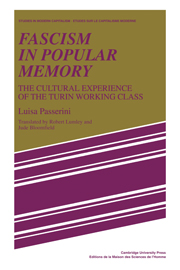Book contents
- Frontmatter
- Contents
- Preface
- Introduction
- I ORAL SOURCES AND THE ANALYSIS OF CULTURAL IDENTITIES
- II ORAL SOURCES AND THE HISTORY OF GRASS-ROOTS CULTURAL FORMS
- III ORAL SOURCES AND THE HISTORY OF THE EVENTS OF EVERYDAY LIFE
- 3 Forms of social acceptance of Fascism
- 4 Resistance to demographic policy
- 5 Mussolini's visit to Mirafiori
- Appendix
- Notes
- Index
4 - Resistance to demographic policy
Published online by Cambridge University Press: 04 August 2010
- Frontmatter
- Contents
- Preface
- Introduction
- I ORAL SOURCES AND THE ANALYSIS OF CULTURAL IDENTITIES
- II ORAL SOURCES AND THE HISTORY OF GRASS-ROOTS CULTURAL FORMS
- III ORAL SOURCES AND THE HISTORY OF THE EVENTS OF EVERYDAY LIFE
- 3 Forms of social acceptance of Fascism
- 4 Resistance to demographic policy
- 5 Mussolini's visit to Mirafiori
- Appendix
- Notes
- Index
Summary
Recollections of the campaign to raise the birth-rate
Some of our subjects offer a description of the Fascist regime with particular reference to its campaign to raise the birth-rate, and their resistance to it. There are not many who refer to this (only 10 women and 4 men) because the issue is a delicate one, especially for practising Catholics, but this is compensated for by the quality of their testimonies, which are of considerable interest.
They overcome their conflicting feelings about the dictator and the regime on the demographic issue, which is seen as a central feature of Fascism. Even those who previously expressed a certain sympathy for the Duce display implacable opposition on this issue. For example, Malvina states ‘Mussolini, what he wanted was there to be a lot of children’, and Emma ‘The Duce was the type who only had a thing against those who didn't marry, he wanted people to marry so that they would have children’, and Tosca ‘Oh Fascism! The Duce! Have babies! Don't think of your husband, have babies, give me babies to slaughter. He only wanted boys. To make war. Then he made it’. The forms of resistance recalled varied. There were those of women who refused to have children and resorted to abortion.
How many children did you have?
fiora I had three.
Are they all alive?
fiora Yes, yes. They're all alive. I would have had more, but you didn't to spite Mussolini, you see.
- Type
- Chapter
- Information
- Fascism in Popular MemoryThe Cultural Experience of the Turin Working Class, pp. 150 - 182Publisher: Cambridge University PressPrint publication year: 1987



